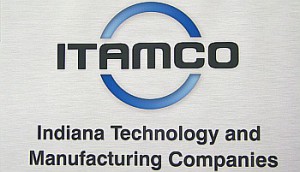 As the technology progresses on additive manufacturing, the way it’s being used in the South Bend – Elkhart Region is as well.
As the technology progresses on additive manufacturing, the way it’s being used in the South Bend – Elkhart Region is as well.
The industry that was $5.2 billion worldwide in 2015 could be $14 billion this year, according to John Pendleton, sales representative for EOS, which produces and sells 3D printing machines. Pendleton was one of seven speakers from local and global companies at the second annual Additive Manufacturing Summit. The event was hosted by ITAMCO, a company headquartered in Plymouth that is one of the region’s leaders in using the technology.
“ITAMCO firmly believes that Additive Manufacturing is the future, and that’s why we want to bring awareness to our region and provide the expertise for regional companies and organizations to be successful in this arena,” said Joel Neidig, director of research and development at ITAMCO (Indiana Technology and Manufacturing Companies).
The event at the Old Bag Factory in Goshen attracted over 60 people from manufacturing, workforce development, real estate and education sectors and all five of the counties in the South Bend – Elkhart (SBE) Region were represented.
Additive Manufacturing is a term that covers 35 different technologies that essentially use metal powder and precise lasers to create 3D printed materials. “It’s a tool in your toolbox. That’s what it is. I would argue that it’s the best, most flexible tool,” said Bob Sutton, managing director and additive manufacturing specialist for Springboard Engineering Solutions LLC. As an engineer and consultant, he has worked with companies learning to best utilize the emerging technology. While it can’t compete with injection molding and conventional production processes for most metal parts, its use and application continue to expand quickly. What was once just for prototypes but is now being used to custom-print individual hearing aids or intricate airplane parts that save millions in fuel usage over the life of the plane.
Lightweighting and customization are two of the advantages of the technology’s use, according to Pendleton. Individualization is another that the auto industry is starting to apply. Mini Cooper is allowing customers to order individualized side scuttles and trim which can be done with AM.
With the high level of manufacturing in the region, the exploration of the technology is progressing rapidly and the potential for its use is almost unlimited. “The South Bend – Elkhart Region has a strong advanced manufacturing sector on which to build,” said Regina Emberton, president and CEO of the South Bend – Elkhart Regional Partnership. “These companies’ ability to infuse new processes like Additive Manufacturing into their daily operations will be key to maintaining competitiveness and expanding economic performance in the SBE Region.”
Fostering the infusion of advanced innovation processes, products, and techniques into the Region’s manufacturing industries is an integral part of the creation of the Labs for Industry Futures and Transformation (LIFT) Network, which will enhance and link cutting-edge expertise, technologies, workforce development programs and innovation-based facilities throughout the broader South Bend – Elkhart Region. A five-year, $42.4 million grant from Lilly Endowment Inc. will advance the region as an economic leader in next-generation manufacturing, entrepreneurship, applied analytics and technology.
“We are creating an unfair advantage,” said Scott Ford, associate vice president for economic development at the University of Notre Dame. “Knitting together emerging research with manufacturing will help the region grow faster than competitors.”
A Goshen location for Kennametal Stellite, a global tooling and wear solutions provider, provides more than 300 unique alloys to customers using Additive Manufacturing. Drake Cargnino, business development engineer for Kennametal Stellite, said they’re seeing demand outside traditional additive segments. A cobalt-based formulation is being used for dental crowns, dentures and bridges. Surgical tooling is using stainless steel alloys. The company invested heavily in two, three-story towers in Goshen that use pressure, inert gases and molten metal to create powder. “We’re still in our infancy,” he said of the work to respond to the growing industry’s demands.
The whole region can benefit by learning how to best use this technology in existing and emerging industries. “As the role of additive manufacturing continues to grow, our region benefits from the opportunities this technology provides for the scope of industry that exist here,” said Jill Scicchitano, director of industry growth for the South Bend – Elkhart Regional Partnership. “The progression of this new technology to foster innovation, greater production efficiencies, and the enhancement of traditional manufacturing techniques will have a significant impact on the operation of many companies based within the South Bend – Elkhart Region.”
To learn more about the 2019 Additive Manufacturing Summit and to view a recap, please visit the Additive Manufacturing Summit website, AdditiveSummit.com.
About South Bend – Elkhart Regional Partnership
The South Bend – Elkhart Regional Partnership is a collaboration of the economic development partners from 47, smart connected communities in Northern Indiana and Southwest Michigan. The Regional Partnership focuses on a long-term systemic approach to advance the region’s economy by aligning the efforts of various stakeholders around five key areas: Educating a world-class WORKFORCE, Recruiting and retaining great TALENT, Attracting and growing new economy companies in complement to our remarkably strong manufacturing INDUSTRIES, Promoting INCLUSION and sparking opportunities for minorities and Helping ENTREPRENEURS thrive. The Regional Partnership seeks to unify and collaborate so that together, the communities across the region work together to achieve what cannot be done individually. For more information about the Regional Partnership, visit SouthBendElkhart.org.













